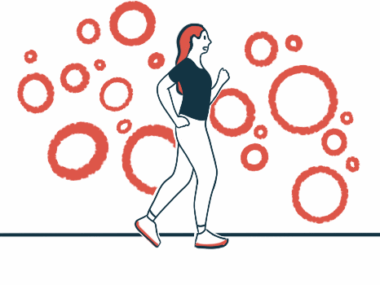MDA 2025: Wearable sensors help to assess CMT function in daily life
Measures captured at the home linked well with more formal tests at clinic
Written by |

Wearable sensors used in the home effectively captured data on physical function that correlated with measures of disease severity taken in the clinic for adults with Charcot-Marie-Tooth disease (CMT), data show.
Such remote monitoring tools can aid in understanding how CMT affects patients in daily life, and may supplement evaluations for assessing treatment effects in clinical trials.
“These wearable sensors can just give us that breadth of extra information in terms of what people are doing at home, where it really matters to them,” Kayla Cornett, PhD, with the University of Sydney, said in an oral presentation at the Muscular Dystrophy Association’s (MDA) Clinical & Scientific Conference, held recently in Dallas and virtually.
The talk was titled, “Remote Monitoring of Physical Activity and Upper Limb Function in Adults with Charcot-Marie-Tooth Disease.”
Trying to determine how patients feel at home, where it ‘matters most’
CMT encompasses a group of conditions affecting the peripheral nerves, the nerves outside the brain and spinal cord that transmit information between those areas and the rest of the body.
Disease symptoms can include motor issues, like muscle weakness and walking difficulties, and sensory problems like abnormal sensations, such as numbness, tingling, or pain.
There are several validated tools to monitor disease progression and therapeutic responses in CMT, ranging from physical function tests, and patient- or clinician-reported outcome measures, to disease biomarkers. Most are collected at clinic or hospital visits.
While such tests are “essential” for CMT monitoring, “they do just capture performance on a single day in a very safe and controlled environment … and not kind of how the patients are functioning where it matters most to them out in the community,” said Cornett, a research associate in inherited neuropathy at the Australian university.
Remote monitoring tools like wearable sensors offer “opportunities to measure patients in their home environment,” she added.
The study’s goal was to test the feasibility of remote data collection for adults with CMT.
Two wearable sensors given to 26 adults to use at home for 14 days
At a Hereditary Neuropathy Foundation event last year, trained clinical evaluators performed functional tests on CMT patients, generating disease severity scores ranging from zero to 100, with 100 being more severe impairments. In these initial assessments, patients also performed some gait and balance tests using wearable sensor devices developed by BioSensics.
Patients then took two of BioSensics’ wearable devices — a pendant worn around the neck and another worn around the wrist — home with them, and wore them continuously for two weeks.
The presentation covered 26 adults, ages 19-70, who have completed the study so far. A range of CMT types were represented and disease severity varied, with severity scores ranging from 27 to 73.
Participants showed very strong compliance, wearing the sensors for most or all of the day, according to Cornett.
Physical activity data collected from the neck pendant revealed a range of activity levels. For example, the time spent walking per day ranged from an average of about 30 minutes to nearly two hours.
According to Cornett, these activity measures “highly correlated” with clinical measures of disease severity. “So the more severe that the patients were, the less time walking, the more time spent [laying about] that they were doing,” the scientist explained.
The same was true for step counts and cadence, with people with more severe disease taking fewer steps overall, and walking fewer steps per minute when moving.
Sensors can pick up subtle changes in things like balance not easily seen
Sensor data collected during gait tests at the initial assessments also associated with clinical disease severity. Sensors worn during physical tests can pick up on subtle abnormalities, such as slight balance issues not visible to the naked eye, Cornett noted.
The wrist sensor, similarly, offered insights into upper limb function and goal-directed movements, referring to purposeful actions taken to achieve a specific outcome (e.g., picking up a water glass). Clinical measures related to upper limb function, namely grip strength, correlated with sensor-collected data on the quality, or smoothness, of goal-directed movements.
CMT patients were performing, on average, about 1,300 goal-directed movements per day, which was similar to the 1,250 such movements observed in a previous study involving people without CMT.
“So they’re still doing a lot of things with their hands and able to achieve all the tasks that they need to in the day, but it’s the quality of achieving those tasks that might be slowing them down or making things more complicated,” Cornett said.
Overall, the sensors “really provided us with a lot of real-world evidence … that reflects patients in their natural environment, and this was correlated with our established clinical outcome assessments of disease severity,” Cornett said.
She indicated that, in the future, the research team plans to test the technology in a larger group of patients, and to look at longer-term data to assess the measures’ sensitivity to change over time.






